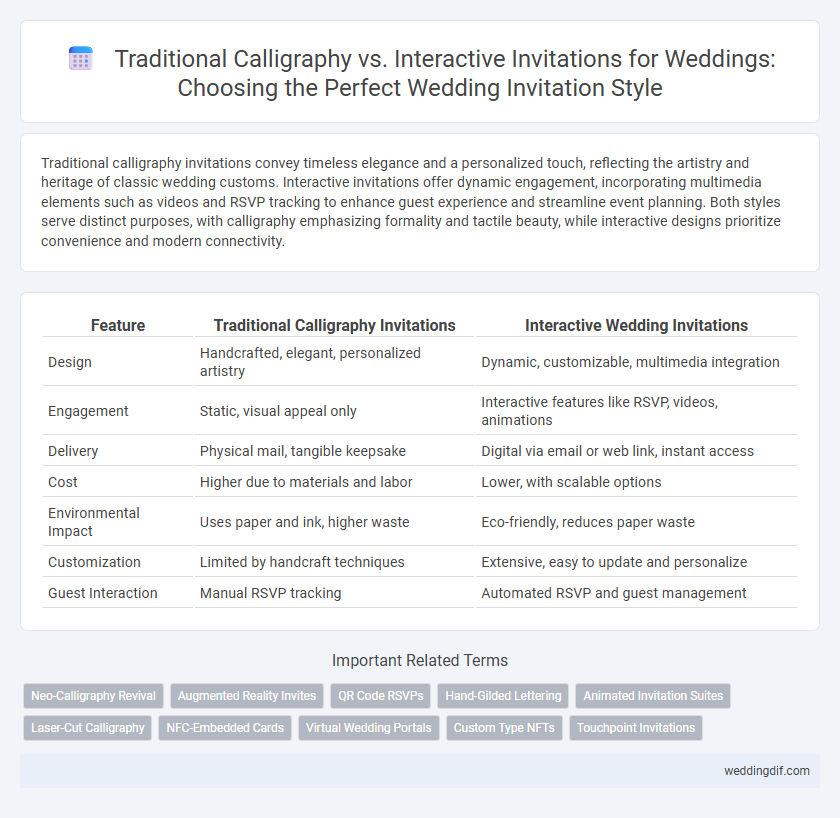Traditional calligraphy invitations convey timeless elegance and a personalized touch, reflecting the artistry and heritage of classic wedding customs. Interactive invitations offer dynamic engagement, incorporating multimedia elements such as videos and RSVP tracking to enhance guest experience and streamline event planning. Both styles serve distinct purposes, with calligraphy emphasizing formality and tactile beauty, while interactive designs prioritize convenience and modern connectivity.
Table of Comparison
| Feature | Traditional Calligraphy Invitations | Interactive Wedding Invitations |
|---|---|---|
| Design | Handcrafted, elegant, personalized artistry | Dynamic, customizable, multimedia integration |
| Engagement | Static, visual appeal only | Interactive features like RSVP, videos, animations |
| Delivery | Physical mail, tangible keepsake | Digital via email or web link, instant access |
| Cost | Higher due to materials and labor | Lower, with scalable options |
| Environmental Impact | Uses paper and ink, higher waste | Eco-friendly, reduces paper waste |
| Customization | Limited by handcraft techniques | Extensive, easy to update and personalize |
| Guest Interaction | Manual RSVP tracking | Automated RSVP and guest management |
Defining Traditional Calligraphy in Wedding Invitations
Traditional calligraphy in wedding invitations involves handcrafted lettering techniques that emphasize elegance, artistry, and timelessness using tools like quills and dip pens. This style often features ornate flourishes and classic scripts such as Copperplate or Spencerian, conveying a sense of sophistication and personalization. Unlike digital or interactive invitations, traditional calligraphy embodies a tangible, artisanal quality that reflects cultural heritage and meticulous craftsmanship.
What Are Interactive Wedding Invitations?
Interactive wedding invitations incorporate digital features such as video messages, RSVP tracking, and animated designs, enhancing guest engagement far beyond traditional calligraphy's static elegance. These invitations leverage multimedia technology to provide seamless communication and real-time updates, making planning more efficient for couples and guests alike. Unlike handcrafted calligraphy, interactive invitations offer customization options that dynamically adapt to each recipient's preferences and responses.
Cultural Significance of Calligraphy in Weddings
Traditional calligraphy in wedding invitations embodies cultural heritage and artistic craftsmanship, often showcasing intricate strokes that symbolize love and unity in many cultures. This timeless art form conveys a sense of formality and respect, deeply rooted in customs passed down through generations. Interactive invitations, while innovative and engaging, often lack the emotional weight and cultural resonance that traditional calligraphy imparts to wedding celebrations.
Personalization and Aesthetic Value: Calligraphy vs Interactive
Traditional calligraphy offers a timeless elegance and personalized touch through handcrafted lettering, making each wedding invitation a unique piece of art with high aesthetic value. Interactive invitations leverage digital technology to enable customizable designs, animations, and multimedia elements, enhancing personalization beyond static visuals. Choosing between calligraphy and interactive formats depends on prioritizing classic sophistication versus dynamic engagement in wedding invitation design.
Guest Experience: Tangible vs Digital Interactions
Traditional calligraphy invitations offer a tactile, personalized experience that guests can cherish as keepsakes, creating a sense of elegance and authenticity. Interactive digital invitations enhance guest engagement through clickable RSVP links, multimedia content, and instant updates, streamlining communication and convenience. Both formats cater to different preferences, balancing the charm of tangible details with the dynamic interactivity of digital technology.
Environmental Impact: Paper vs Digital Invitations
Traditional calligraphy invitations often use high-quality paper, ink, and embellishments, resulting in significant environmental impact due to resource consumption and waste production. Interactive digital invitations eliminate paper waste entirely, reducing carbon footprint by minimizing printing and transportation emissions. Choosing digital invitations supports sustainable wedding planning by conserving natural resources and promoting eco-friendly communication methods.
Cost Comparison: Traditional Ink vs Interactive Tech
Traditional calligraphy invitations often incur higher costs due to skilled labor, handcrafted ink application, and premium paper materials, typically ranging between $5 to $15 per card. Interactive wedding invitations, utilizing QR codes, augmented reality, or digital customization, offer scalable pricing with initial tech setup expenses offset by lower per-invite distribution costs, often below $3 each. Couples balancing budget and personalization should evaluate the long-term savings and enhanced guest engagement provided by digital formats against the artisanal value and tactile experience of traditional ink invitations.
RSVP Management: Manual Tracking or Digital Convenience
Traditional calligraphy invitations offer a timeless aesthetic with hand-addressed RSVP cards requiring manual tracking of guest responses, often leading to potential delays or errors. Interactive wedding invitations integrate digital RSVP platforms that streamline guest management, enabling real-time tracking, automated reminders, and instant updates for hosts. Choosing between classic elegance and digital convenience depends on the couple's preference for personalized artistry versus efficient, data-driven event organization.
Trends: Are Modern Couples Shifting Preferences?
Modern couples increasingly favor interactive invitations that integrate digital elements like QR codes and animated designs, enhancing guest engagement and convenience. Traditional calligraphy remains valued for its timeless elegance and personalized artisan touch, often used for formal or heritage-themed weddings. Current trends indicate a balanced shift, where hybrid invitations blend classic calligraphy with interactive features to satisfy both aesthetic and technological preferences.
Choosing the Best Fit for Your Wedding Style
Traditional calligraphy offers timeless elegance and a personalized touch that reflects classic wedding styles, making it ideal for formal or vintage-themed ceremonies. Interactive invitations provide dynamic engagement through digital interactivity and real-time RSVP tracking, perfect for modern, tech-savvy couples seeking convenience and customization. Assessing your wedding theme, guest preferences, and desired level of formality can help determine whether the classic allure of calligraphy or the innovative features of interactive invites best complements your celebration.
Traditional calligraphy vs interactive invitations for weddings Infographic

 weddingdif.com
weddingdif.com